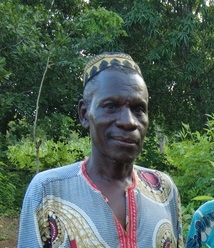Agroecology, crop diversity, soil fertility, pasture
Orou Douarou Assouma


Orou Douarou Assouma, a farmer from Guéssou (Gbégourou) in Benin, cultivates his land and raises livestock following agroecological principles. Here’s a portrait of his farm.
Context
- Name: Orou Douarou Assouma.
- Location: Guéssou (Gbégourou), Benin.
- Cultivated Area: 8 hectares.
- Soil Texture: Sandy loam.
- Workforce: 3 permanent workers assisted by their 2 sons. Additionally, 3 of their wives occasionally help, mainly during harvests, which benefit the family.
- Production: Mainly for family consumption:
- Vegetable crops: Tomato, lentil, peanut, cowpea, pigeon pea, and velvet bean (mucuna).
- Food crops: Cassava, sorghum, maize, soybean.
- Fruit and forest trees: Shea tree, cashew tree, teak (Gmelina arborea, also known as white teak) for field boundaries.
- Livestock: Poultry (50 birds), goats (4), sheep (6).
- Climate: Guessou-Nord has a savanna climate with a dry winter (Aw classification according to Köppen-Geiger). The average annual temperature is 27.8°C, with 904.9 mm of rainfall. Winds appear toward the end of the rainy season.
- Education/training/background: Orou learned agriculture from his parents and still applies the traditional techniques and methods they taught him. He has no formal education in agriculture or agronomy; his knowledge is empirical. Since last year, through the ProSilience project, he has started combining traditional and agroecological approaches.
Motivations and objectives
Orou’s interest in agroecology emerged a year ago with the ProSilience project and support from the Monrado Consultancy (an agricultural advisory firm). One of Orou’s goals is to implement the techniques introduced by the ProSilience project. Before this, he lacked knowledge about agroecology, such as enriching the soil with pigeon pea, mucuna, and other suitable legumes. He recognizes their significant benefits for himself and future generations.
Agronomic aspects
Farming practices

Soil fertility management
- Orou improves soil fertility by planting maize before mucuna and rotating crops to enhance soil quality between maize cycles.
- Plowing and burying weeds into ridges enriches the soil with nitrogen and organic matter.
- With the ProSilience project, he began rotating crops on different plots—for example, avoiding maize on maize sequences this year.
- He now practices crop association, such as:
- Cassava and maize.
- Cowpea and maize.
- Sorghum and peanut.
- Pigeon pea and peanut under cashew trees.
- Orou values his land by cultivating pigeon pea and mucuna, which not only enhance soil fertility but can also be consumed after processing.
Soil management
Orou plows his fields annually. Recently, he began leaving some plots unplowed as a test, saving time and enabling mulching (adding organic litter at the base of crops like soybean, sorghum, and maize).
Plowing methods include:
- Using oxen-drawn plows.
- Manual plowing.
- Using a tiller.

Pest management
- Corn borers: These pests damage maize by eating its male inflorescence, disrupting reproduction.
- Locusts.

Strategies to address challenges
- Lack of resources for plowing and insufficient equipment, which delays crop establishment: His solution is to use multiple tools/methods.
- Against caterpillars: Through the project, he learned to produce biopesticides using local vegetation, such as neem, tobacco leaves, traditional soap, and crushed chili peppers.
Water system
There is no irrigation system in place.
Social aspects
Satisfaction/dissatisfaction
- Workload: Work intensity varies throughout the year, especially during plowing (June, July) and sowing, which are labor-intensive periods.
- Living conditions: Fields are 4 km away, which Orou finds reasonable compared to other farmers with plots up to 16 km away.
Environment
Technical support/assistance
- By the Monrado Consultancy.
- Through the ProSilience project.
- Past support from the national structure on communal development for agricultural outreach on conventional and field-developed techniques.
- Collaboration with Hunger Project, focusing on climate change adaptation in farm management.
Cooperation with other farmers
- Orou is part of a farmers’ group addressing common issues, such as the cotton producers’ association, which is well*organized. Otherwise, there are no other significant associations.
- A working group tackles shared challenges with support from the Monrado office.
Economic aspects
- Monthly income: None, as it’s a family farm, and no direct salaries are drawn.
- Land cost: 1 hectare costs 500,000 FCFA, decreasing with distance from the village.
- Equipment: Hoe, a plow, but no oxen currently.
- Financial assistance/donations: None.
- Expenses: Labor costs for plowing are the highest, amounting to 280,000 FCFA for the entire farm.
- Revenue: Primary focus is personal consumption before selling surplus. Soybeans are the most profitable, with 8 sacks of 50 kg sold annually at 22,000 FCFA per sack.
- Marketing strategy: Sales are made to local retailers or individuals who buy directly from the field.
Advice from the farmer
To preserve soil health, it’s essential to minimize mechanical interventions, practice crop rotation, and adopt soil conservation techniques. Orou is willing to guide others interested in starting farming by sharing his management methods and soil conservation techniques.
Photo gallery
Sources
Interview with Orou Douarou Assouma conducted in August 2024 by the Ver de Terre Production team as part of the Urbane project. Photo Credits: Ver de Terre Production.
This page was written in partnership with the Urbane project and with the financial support of the European Union.





